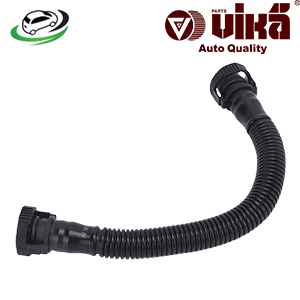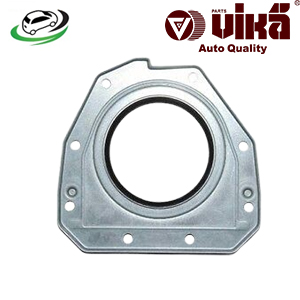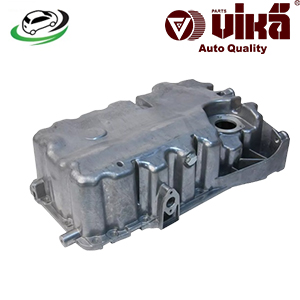-5%
Get Engine Oil Pan Installation Kit VW EOS 2.0T/ Golf V 2.0T/ Jetta V 2.0T/ Passat B6 FWD 2.0T 06F103601L
An engine oil pan installation kit is an essential set of tools and components designed to assist in the proper installation or replacement of an engine oil pan. The oil pan is a critical component of an engine, serving as the reservoir for engine oil, which lubricates and cools the engine’s moving parts. Ensuring a proper installation is vital for maintaining engine health and preventing oil leaks. This guide will cover the components of a typical engine oil pan installation kit, the installation process, and best practices for ensuring a successful and leak-free installation.
Components of an Engine Oil Pan Installation Kit
A standard engine oil pan installation kit typically includes the following components:
- Oil Pan Gasket
- Material: The gasket is usually made from materials such as rubber, cork, silicone, or a multi-layered steel composite, each chosen for its ability to create a tight seal between the oil pan and the engine block.
- Function: The gasket is crucial for preventing oil from leaking out of the oil pan. It forms a seal that keeps the engine oil contained while allowing the oil pan to be securely attached to the engine.
- Oil Pan Bolts and Fasteners
- Types: The kit often includes a set of new bolts, washers, and fasteners specifically designed for attaching the oil pan to the engine block. These fasteners are typically made from high-grade steel to ensure strength and durability.
- Importance: Using the correct bolts and fasteners is essential for maintaining the proper torque and ensuring that the oil pan is securely fastened without warping or damaging the gasket.
- Drain Plug and Washer
- Drain Plug: Some kits may include a new oil drain plug and washer. The drain plug is used to remove old engine oil during oil changes, and a fresh plug can help ensure a proper seal and prevent leaks.
- Washer: The washer, often made of copper or aluminum, is placed between the drain plug and the oil pan to provide an additional seal.
- Silicone Sealant or RTV (Room Temperature Vulcanizing) Sealant
- Usage: Some engine oil pan installation kits come with a tube of silicone or RTV sealant, which is used in conjunction with the gasket to ensure a complete seal, particularly around corners and joints where leaks are more likely to occur.
- Application: Sealant is applied to the gasket or directly to the engine block before the oil pan is installed. It helps to fill in any gaps or imperfections, further preventing oil leaks.
- Oil Pan Baffle (Optional)
- Purpose: In performance-oriented kits, an oil pan baffle might be included. The baffle helps to control the movement of oil within the pan, especially under high-performance driving conditions, preventing oil starvation and ensuring consistent oil pressure.
Benefits of Engine Oil Pan Installation
1. Prevents Oil Leaks
- Seals Engine Oil: A properly installed oil pan ensures that the engine oil remains sealed within the engine, preventing leaks. Oil leaks can lead to a drop in oil levels, which can cause insufficient lubrication and result in engine wear or damage.
- Protects the Environment: By preventing oil leaks, a correctly installed oil pan helps avoid environmental contamination. Oil leaks can pollute soil and water sources, leading to environmental hazards.
2. Maintains Optimal Engine Lubrication
- Ensures Adequate Oil Supply: The oil pan holds the engine’s oil supply, and a proper installation ensures that the oil is always available for circulation. This is crucial for maintaining the lubrication of engine components, reducing friction, and preventing wear.
- Supports Oil Circulation: A well-installed oil pan ensures that oil flows smoothly through the engine’s lubrication system, reaching all critical components like the crankshaft, bearings, and camshaft.
3. Enhances Engine Cooling
- Dissipates Heat: The oil pan plays a role in engine cooling by dissipating heat from the engine oil as it circulates through the system. A properly installed oil pan maximizes the surface area exposed to air, aiding in heat dissipation and preventing the engine from overheating.
- Supports Oil Cooling: In addition to direct cooling, the oil pan helps cool the engine oil itself, which in turn helps lower the overall temperature of the engine.
4. Increases Engine Longevity
- Prevents Contamination: A secure oil pan installation prevents dirt, debris, and contaminants from entering the oil system. Contaminated oil can cause abrasive wear on engine components, leading to premature failure.
- Protects Engine Components: Proper installation ensures that the oil pan provides adequate clearance and protection for the engine’s crankshaft and connecting rods, reducing the risk of damage.
5. Improves Engine Performance
- Maintains Oil Pressure: A well-installed oil pan ensures consistent oil pressure within the engine. Adequate oil pressure is crucial for the proper functioning of hydraulic systems like variable valve timing and hydraulic lifters, which can affect engine performance.
- Supports High-Performance Applications: For high-performance engines, proper oil pan installation is critical. Performance oil pans often feature baffles and traps that prevent oil starvation during aggressive driving, ensuring the engine performs optimally under all conditions.
6. Prevents Oil Starvation
- Ensures Proper Oil Pickup: The oil pan is designed to provide the oil pump with a consistent supply of oil. A correctly installed oil pan ensures that the oil pickup remains submerged in oil, preventing air from being drawn into the system and causing oil starvation.
- Supports Engine Safety: Oil starvation can lead to catastrophic engine failure. By ensuring the oil pan is installed correctly, you mitigate the risk of oil starvation, particularly during hard acceleration, cornering, or braking.
7. Reduces Maintenance Costs
- Prevents Costly Repairs: By preventing leaks, ensuring proper lubrication, and protecting engine components, a well-installed oil pan reduces the likelihood of costly engine repairs or overhauls.
- Extends Oil Life: Proper installation helps maintain the quality of the engine oil, reducing the frequency of oil changes and lowering overall maintenance costs.
8. Ensures Proper Fit and Function
- Avoids Alignment Issues: Proper installation ensures that the oil pan is correctly aligned with the engine block and other components. Misalignment can lead to leaks, poor oil flow, and damage to the oil pan or engine block.
- Prevents Interference: A correctly installed oil pan provides the necessary clearance for the crankshaft and connecting rods, preventing interference that could cause noise, vibration, or damage.
9. Supports Advanced Engine Technologies
- Accommodates Sensors and Valves: Modern engines often feature sensors and valves integrated into or near the oil pan. Proper installation ensures that these components function correctly, providing accurate readings and controlling oil flow as designed.
- Integrates with Engine Management Systems: Many modern engines use data from sensors in the oil pan to manage engine performance and efficiency. A correctly installed oil pan ensures that these systems operate as intended.
10. Improves Vehicle Resale Value
- Indicates Good Maintenance: A properly installed oil pan, free from leaks and damage, is a sign of good vehicle maintenance. This can improve the resale value of the vehicle, as potential buyers will see it as a well-maintained and reliable option.
- Enhances Aesthetic Appeal: While often hidden, a clean, well-installed oil pan can contribute to the overall aesthetic appeal of the engine bay, particularly for car enthusiasts and collectors.
Signs of a faulty Engine Oil Pan Installation
1. Oil Leaks
- Visible Leaks: The most common sign of a faulty installation is oil leaking from the oil pan area. You might see oil spots or puddles under your vehicle, particularly around the edges of the oil pan or drain plug.
- Dripping or Puddling: Persistent dripping or puddling of oil on the ground or within the engine bay can indicate that the oil pan is not sealing properly.
2. Check Engine Light
- Activated Warning: If the oil pan installation is faulty, it can trigger the check engine light on your dashboard. This may happen if sensors detect low oil pressure or other issues related to improper installation.
- Diagnostic Codes: A scan tool may reveal error codes related to the oil system or oil pressure, pointing to potential problems with the oil pan or its installation.
3. Low Oil Pressure
- Oil Pressure Warning Light: If the oil pan is not installed correctly, it can lead to inadequate oil pressure. This can trigger the oil pressure warning light on the dashboard.
- Fluctuating Oil Pressure: Erratic or fluctuating oil pressure can also be a sign of an issue with the oil pan installation, particularly if the oil pickup is not properly aligned or if there are leaks.
4. Engine Noise
- Unusual Sounds: A faulty oil pan installation can cause unusual engine noises such as knocking, ticking, or tapping. These sounds may be due to insufficient oil flow or oil starvation, which can occur if the oil pan is not properly sealed or aligned.
- Metallic Sounds: If you hear metallic sounds, it could indicate that the engine components are not being adequately lubricated due to oil leaks or low oil levels.
5. Oil Starvation Symptoms
- Performance Issues: Symptoms of oil starvation, such as reduced engine performance, hesitation, or stalling, can be caused by a faulty oil pan installation. If the oil pickup is not properly positioned, it can lead to insufficient oil supply to critical engine components.
- Overheating: Insufficient oil can lead to engine overheating as the oil also helps in cooling the engine. If you notice your engine running hotter than usual, it may be related to oil pan issues.
6. Visible Damage or Misalignment
- Cracked or Damaged Pan: Inspecting the oil pan itself may reveal visible signs of damage, such as cracks or dents. Damage to the oil pan can result from improper installation or alignment issues.
- Gasket Issues: Check for visible signs of gasket damage or misalignment. A gasket that is improperly seated or crushed can lead to leaks and other installation problems.
7. Excessive Oil Consumption
- Frequent Refilling: If you notice that you are having to refill your engine oil more frequently than usual, it could be a sign of a faulty oil pan installation leading to leaks.
- Low Oil Levels: Regularly checking the oil level and finding it to be lower than expected can indicate that oil is escaping due to improper installation.
8. Smoke from the Engine Bay
- Burning Oil Smell: If oil is leaking from the pan and coming into contact with hot engine components, you might notice smoke or a burning oil smell. This can be a clear sign of a problem with the oil pan installation.
9. Inconsistent Oil Pressure Gauge Readings
- Erratic Readings: If your vehicle has an oil pressure gauge, erratic or inconsistent readings can indicate problems with the oil pan installation. This could be due to a faulty gasket, leaks, or a misaligned oil pickup.
10. Difficulty Starting the Engine
- Hard Starts: In severe cases, insufficient oil supply due to a faulty oil pan installation can cause difficulty starting the engine. This is usually accompanied by other symptoms such as low oil pressure or unusual engine noises.
Follow us on Facebook for more parts.



